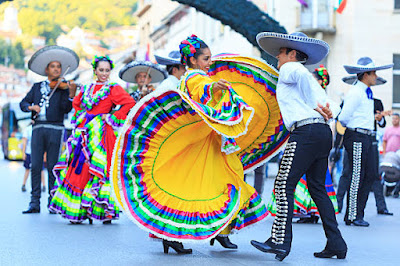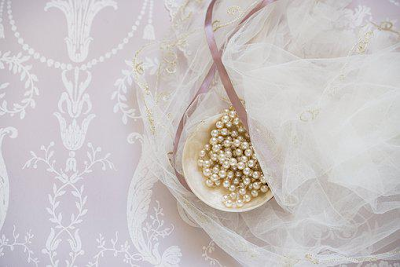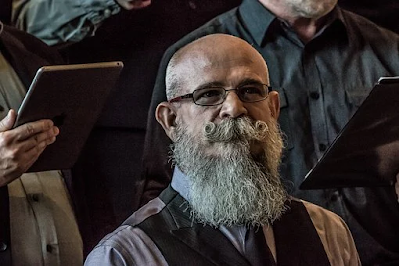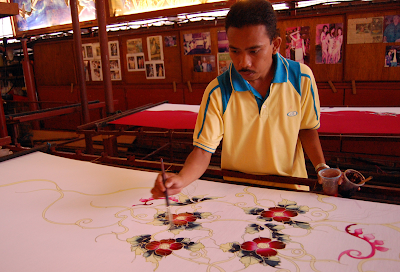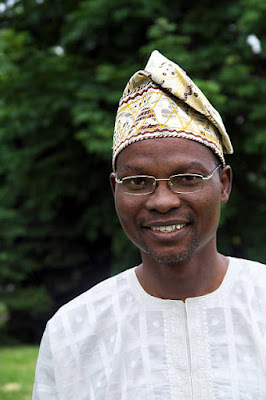Featured
- Get link
- X
- Other Apps
HISTORY OF DRESS IN CENTRAL AMERICA AND MEXICO.
Clothing and fabric are examples of cultural items that function as visual indicators in a silent language.
This is a kind of visual literacy: learning the language of textiles is comparable to learning to read, only it involves learning how to read fabric, clothes, and how it is worn.
Traditional clothes worn by indigenous peoples of Mexico and Central America may astonish and surprise the untrained eye.
- It may be embroidered or handwoven with geometric, floral, animal, or human motifs in a kaleidoscope of colors, or it can be embellished with commercial trimmings.
- Clothing may convey information about a person's position, class, status, location (region or town), religion, or age (Schevill 1986).
Geography and Weather's Impact On the Clothing Of Central America.
Cool temperate highlands and warm tropical lowlands and islands are found in Mexico and Central America.
The Sierra Madre, which stretches into southern Mexico and Central America, comprises the highlands and is mostly populated by indigenous peoples, cuts through the huge northern desert.
The Pacific Ocean lies to the west, while the Gulf of Mexico and the Caribbean Sea are to the east.
Volcanoes, thick tropical rainforests, vast lengths of seashore, steep gorges, and lush mountain valleys all have a shared cultural past that spans over 3,000 years, from 1500 B.C.E. to 1519 C.E.
Great ceremonial hubs arose in far-flung geographic regions linked by commerce routes.
Persistence and Innovation In Central American Clothing.
Varying environmental circumstances and a vast range of raw materials have impacted the development of clothes and cultivated the diversity of styles in use in the early twenty-first century.
Why has traditional clothing and fabric manufacture continued in portions of Mexico, Guatemala, and Panama but not in Honduras, El Salvador, Nicaragua, or Costa Rica?
The physical isolation of towns and regions; the continuation of marketplaces and the fiesta cycle; the symbolization of local values in dress; and the distinction of civil-religious hierarchies via clothes are all elements to examine.
Closer to the city, men's and children's Western-style clothing has supplanted traditional clothing.
The urge to look like the rest of the world, fueled by media and tourism, has given rise to a market for jeans, T-shirts, and athletic footwear.
Outsiders have regarded indigenous peoples as innately conservative and resistant to change in the past.
However, two opposing principles influence textile production:
- the aesthetic, creative need to develop
- and the conservative, tradition-bound constraint.
New materials, methods, and patrons—tourists, businesspeople, or counselors involved in selling textiles abroad—inspire loom and needle artists.
The fashion impulse is an aspect of innovation, and new clothing trends may be seen in the way a garment is worn, the colors and patterns, and the layout among certain age groups (Schevill 1997, pp. 129–143).
Dress as like you're a Survivor.
Pre-Columbian clothing form survivals, such as the woman's huipil, or upper body garment, and the little shoulder quechquémitl, or shawl, as well as the man's cal zones, or trousers, and a sleeveless jacket, xicolli, are all present in current indigenous dress.
There are also Hispanic clothing form relics.
Only a few examples are women's blouses, head veils, gathered skirts, men's fitted trousers and jackets, sombreros, and, of course, both men's and women's shoes.
Combinations of Western and Traditional Styles.
Males from both urban and rural areas continue to leave their homes on a seasonal basis to work on big coffee and cotton fincas (plantations) and dress in Western-style attire to avoid racial discrimination.
People return to their villages during fiestas, wearing traditional dress and partaking in traditional pastimes known as costumbre.
Both women and men may wear traditional clothes as well as Western-style apparel.
An excellent example is the shawl known as the rebozo or perraje (Logan et al. 1994).
Rebozos are worn by both ladinas and mestizas (those of mixed Indian, African, and/or Spanish origin who do not belong to one of the indigenous cultural groups).
Another fashion trend is the appropriation of foreign clothing styles from countries other than Spain.
Under the influence of missionaries, the Tarahumaras (Raramuris) of Chichuahua's Sierra Madre assimilated features of non-Indian culture while keeping indigenous handicrafts such as weaving.
Their clothes are handcrafted from commercially printed fabric and include voluminous skirts and blouses, some with peplums.
Women use bandannas to cover their heads, but males continue to wear white commercial cotton turbans and loincloths (Green 2003).
Todos Santos's male Mam speakers Cuchumatán, Huehuetenango (Guatemala) adopted black woolen fitted overpants from the French Navy who visited Guatemala in the mid-nineteenth century and wore them over their own handwoven long pants.
The San Blas islands, off the northern coast of Panama, are populated by indigenous Kunas in southeastern Central America.
Molas, or blouses, for ladies are constructed of colorful commercial cotton.
The front and back of a woman's shirt are adorned with two identical beautifully hand-stitched appliquéd panels.
Outside influences are reflected in some of the images, which may be seen on billboards, advertisements, and television.
The Weaver's Art
Women were supposed to weave for themselves and their families before the Conquest, as well as manufacture ceremonial clothing for temples and offerings.
Even in the twenty-first century, a skilled weaver had sta tus in the society.
When clothing and fabric were created for sale, they also brought in additional money.
Children learnt to spin, prepare yarn, warp the loom, and weave by imitating their moms.
Weaving must be taken seriously by the age of twelve, whether they like it or not.
It's like a game before that, but by the age of sixteen, a lady must be an experienced weaver.
Since 1500 B.C.E., the backstrap loom has been used in Mexico and Central America.
A weaver working her backstrap loom is shown in a Classic Maya ceramic figure unearthed at Jaina Island off the eastern coast of Mexico.
This loom is also known as the hip-loom or stick-loom (telar de palitos), and it is primarily associated with women, despite the fact that both male and female indigenous weavers create fabric on it.
Only the sticks and ropes remain when the fabric, which is typically selvaged on both ends, is taken from the loom.
Staked, horizontal looms, and floor or treadle looms, introduced by the Spanish after the Conquest, are also in use.
This kind of weaving was taught to indigenous men, who quickly learned how to make yardage, which was required for the Spanish cut-and-sew fitted clothing.
Zapotec male weavers in Teotitlán del Valle, Oaxaca (Mexico), make beautiful woolen carpets and blankets on treadle looms in the early 2000s, while Maya men weave double-ikat cotton material for skirts in Salcajá, Quezaltenango (Guatemala).
To weave headbands, both male and female weavers in Totonicapán (Guatemala) employ a unique loom that combines aspects of the back strap and treadle loom.
Furthermore, both draw and jacquard loom weavers generate intricate yardage.
Materials In Central American Clothing.
Since pre-Columbian times, cotton has been the most significant fiber for weavers.
A long-staple white cotton and a short-staple, tawny-colored cot ton known as ixcaq, ixcaco, coyuche, or cuyuscate are the two types.
Agave, yucca, and other vegetative fibers are still used, as well as cultured rabbit hair and feathers.
The Tzotzil women of Zinacan tán, Chiapas, continue to wear the feathered bridal gown (Mexico).
Wool was quickly accepted by local weavers when the Spanish imported sheep because of its warmth, robust and thick texture, and ability to absorb colors.
Colored imported silk, pearl cotton, different embroidered cottons, and synthetic yarn are used for embellishment.
Dyes Used In Central American Clothing.
Natural colors used in pre-Columbian textiles are not known with confidence due to the scarcity of archaeological textile remnants.
Some hints may be found in the painted codices, pottery, and other visual materials (Anawalt 1981).
Indigo (blue), brazil wood, and cochineal (red), palo de tinta (black), cinnabar (red-brown), and pur pura patula (lavender) were all possible colors.
The introduction of chemical dyes in Europe in 1856 broadened the world's color pallet.
These dyes were soon embraced, and they were used in conjunction with certain natural colors.
Natural dyes were reintroduced to several Mexican and Guatemalan weavers and embroiderers in the early 2000s.
Rainbow-colored clothes is an expected and joyful feature of 21st-century fashion.
Techniques Used In Central American Clothing.
One of the most commonly portrayed methods in these countries is brocading.
It's a method of embellishing the fabric while it's still on the loom.
Brocading may be divided into three categories:
- single-faced brocading with a discernible pattern on one side;
- two-faced brocading with ornamental yarn floating between pattern regions on the reverse side, producing an inverse of the design;
- and double-faced brocading with a virtually identical pattern on both sides.
Embroidery is the most common method, followed by knitting, beading, crocheting, and more.
As with the adoption of chemical colors, the sewing machine and the availability of commercial fabric and trimmings have displaced what was formerly done by hand in many areas.
Central American Iconography.
The iconography is diverse. In a realistic, stylized, or abstract manner, geometric forms, plants, animals, and human images are weaved together.
Because these motifs are part of the communal psyche or legendary past, the specific significance of these designs to the weavers may never be understood. Clothing is a kind of memory.
Central American Garment Repertoire.
Throughout this huge geographic region, indigenous dress is worn in a wide range of styles.
Individual clothing styles, on the other hand, are a common tradition.
Women.
The top garment, also known as the huipil in Nahua, is the most essential part of a woman's dress.
The Aztec language, Nahua, is still spoken in many Mexican towns today.
The huipil is made up of two or three backstrap or floor-loomed sections that are sewn together and include neck and arm holes, often with ornate embroidery.
Embroidered or commercial fabrics, such as ribbons or rickrack, may be added after the designs have been woven in.
The Zapotecs of Oaxaca, Mexico, and the Mayas of Chiapas, Yucatán, and Guatemala wear mostly exquisite, handwoven, or embroidered huipiles.
Skirts are gathered to a waistline or wrapped around and kept in place by broad or thin handwoven belts.
The fabric might be a plain hue, such as dark blue, or a patterned floor loomed cotton design.
The K'iche' and Cakchiquel Mayas (in Guatemala) have exceptional tie-dyed or ikat (jaspe) colorful skirts.
Backstrap-loomed textiles are vital for covering the head and wrapping food and belongings.
Cut-and-sew clothes, often known as aprons, are a Hispanic clothing form that serves both ornamental and functional functions.
The head and hair are extremely vital to beautify.
Many Mayas use tapestry woven headbands with ornate tassels, while the Yalalags of Oaxaca wear thick yarn headdresses.
The skill of the embroidered blouse with the sewing machine has been achieved by the ladies of the northern Sierra of Puebla (Mexico) (Anawalt and Berdan 1994).
Young Maya women in Chiapas stitched designs on commercial-cloth blouses in the early 2000s, while before, the decoration was achieved by extra weft brocading.
Older Nahua and Otomi women in Puebla still wear the quechquémitl, a capelike shoulder garment, while large shoulder cloths are common throughout the region.
Sandals and jewelry, it seems, complete the woman's ensemble.
Men.
White manta or commercial cotton, as well as handwoven colorful material, are used to make tailored pants that are loose-fitting and held up by a broad belt.
The shirts, like the women's huipiles, may be loom-decorated.
Cotton and wool are used to knit or crochet shoulder bags.
Men often make their own bags.
Others are built to be sold as a popular tourist attraction.
In colder climates, males should wear black or multicolored wool overgarments with shoulder or hip blankets.
Under the sombrero, handwoven head coverings may be worn in a pirate style.
Sombreros are often adorned with hatbands.
Over the shirt, tailored cotton or wool coats, as well as the sleeveless version, are worn.
Sandals or shoes are also worn by men.
Children.
Special Occasions for Special Central American Clothing.
Each region has various forms of dress for special occasions; these fashions are developed from family or regional traditions and often pay respect to historical incidents.
Cofradas.
Cofradas are religious groups for men and women affiliated with the Catholic Church.
Participants look after the church, the saint statues, and frequently host religious services in their own homes.
Women wear ceremonial huipiles, while males wear unique headcloths, coats, and caps to show their status in the community.
Contests, Festivals, and Fiestas.
The indigenous people dress up for significant events.
During example, white ruffled cotton blouses with red embroidery and long white ruffled skirts substitute Western-style attire in El Salvador for fiestas (Valasquez 2003).
In various parts of Guatemala and Mexico, beauty pageants are held in which indigenous and ladina candidates dress up in the most beautiful traditional costume they can find.
Costumed dances, generally of Spanish origin, are performed during fiestas commemorating saints' days, and specific rental dancing costumes are necessary on these occasions.
A young woman's quinceaera, or fifteenth birthday celebration, is another occasion for distinctive attire.
The confluence of clothing styles and materials from the Old and New Worlds gives contemporary Mexican and Central American fashion its richness and diversity.
See also:
References And Further Reading:
- Get link
- X
- Other Apps

